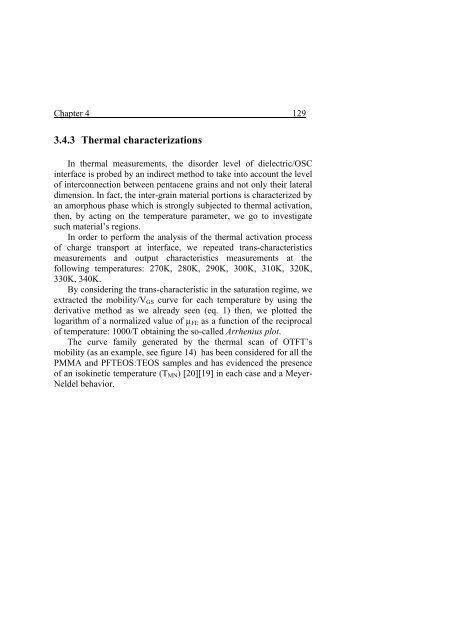tesi R. Miscioscia.pdf - EleA@UniSA
tesi R. Miscioscia.pdf - EleA@UniSA
tesi R. Miscioscia.pdf - EleA@UniSA
You also want an ePaper? Increase the reach of your titles
YUMPU automatically turns print PDFs into web optimized ePapers that Google loves.
Chapter 4 129<br />
3.4.3 Thermal characterizations<br />
In thermal measurements, the disorder level of dielectric/OSC<br />
interface is probed by an indirect method to take into account the level<br />
of interconnection between pentacene grains and not only their lateral<br />
dimension. In fact, the inter-grain material portions is characterized by<br />
an amorphous phase which is strongly subjected to thermal activation,<br />
then, by acting on the temperature parameter, we go to investigate<br />
such material’s regions.<br />
In order to perform the analysis of the thermal activation process<br />
of charge transport at interface, we repeated trans-characteristics<br />
measurements and output characteristics measurements at the<br />
following temperatures: 270K, 280K, 290K, 300K, 310K, 320K,<br />
330K, 340K.<br />
By considering the trans-characteristic in the saturation regime, we<br />
extracted the mobility/VGS curve for each temperature by using the<br />
derivative method as we already seen (eq. 1) then, we plotted the<br />
logarithm of a normalized value of µFE as a function of the reciprocal<br />
of temperature: 1000/T obtaining the so-called Arrhenius plot.<br />
The curve family generated by the thermal scan of OTFT’s<br />
mobility (as an example, see figure 14) has been considered for all the<br />
PMMA and PFTEOS:TEOS samples and has evidenced the presence<br />
of an isokinetic temperature (TMN) [20][19] in each case and a Meyer-<br />
Neldel behavior.
















